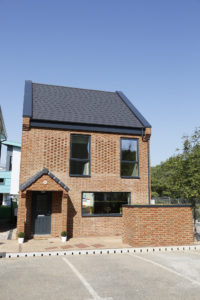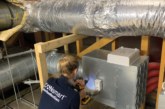
PHPD spoke to Gwyn Roberts, New Homes and Communities lead at BRE, to find out more about the organisation’s new Home Quality Mark and the opportunities for housebuilders.
Anyone who has ever considered buying anything online will know that rating schemes are gaining in prominence. Many of the world’s most popular online shops feature them heavily as consumers seek out the 5-star ratings for more information about potential purchases.
A similar 5-star rating scheme may also soon be found on many new homes. But whilst online shops rely on customers to provide feedback and rate products the new Home Quality Mark (HQM) – run by the BRE – is slightly more involved. Sitting behind the 5-star label is a considered methodology put together following cross-industry discussion and involvement. The result, the BRE hopes, is an assessment scheme that incorporates a number of categories, measuring not only the final new home but also the processes involved in building it and incorporating a reflection of how well the new home sits within its local environment.
Market differentiation
Launched at Ecobuild in March 2015 the Home Quality Mark is intended to provide potential homebuyers with an impartial indication of the attributes of the new build homes they are considering. As an impartial rating, the HQM has been designed to inform and educate buyers enabling them to make a considered opinion on the benefits of each new home.
On the other side of the coin housebuilders can use the mark to market and  differentiate their properties – demonstrating to buyers the qualities of their new homes. So buyers will, for example, be able to see if a home is cheaper to run, or will need less maintenance, or creates a more healthy environment, or has low CO2 emissions etc…
differentiate their properties – demonstrating to buyers the qualities of their new homes. So buyers will, for example, be able to see if a home is cheaper to run, or will need less maintenance, or creates a more healthy environment, or has low CO2 emissions etc…
Gwyn Roberts, New Homes and Communities Manager, BRE Global explained: “A new national quality mark will give those buying or renting new homes the confidence that they are choosing a well built, cost-effective home that is designed and built to exceed expectations.”
Scope of assessment
Although an overall star rating out of five will be given for each new property, buyers will also be able to see a scorecard of results indicating Cost, Wellbeing and (environmental) Footprint.
The scores are generated following an independent assessment of three constituent areas: Knowledge Sharing, Our Surroundings & My Home.
Knowledge Sharing looks at the processes used by members of the construction team (architects, designers, builders, householders etc…) and rewards practices that encourage open interaction between parties to minimise issues such as ’the Performance Gap’ where buildings often underperform in comparison with the original design promises.
Our Surroundings takes into account the environment in which a new home sits, rewarding homes which work with their local features to maximise positive benefits.
My Home covers the performance of the home itself, using established assessment methodologies and simple calculations to determine if the new home is a space in which it is healthy to live, while not costing the earth to run.
Gwyn Roberts noted: “HQM provides and overall measure of quality of the home, its design quality, the materials used and how it has been put together. Further to this, it provides a rating on the costs of living in the home, the impact upon the occupiers health and wellbeing and the overall environmental footprint.”
Independent assessment
 The assessment takes place in two phases. The initial assessment is undertaken at the design phase with a final assessment once the home has been built. In the same way as BREEAM assessments are undertaken on larger buildings, assessments will be carried out by trained independent HQM assessors contracted by a housebuilder to perform this role. The BRE is generating software packages – and joining up with other software that the building industry uses such as SAP and BIM – to help ensure bureaucracy is kept to a minimum.
The assessment takes place in two phases. The initial assessment is undertaken at the design phase with a final assessment once the home has been built. In the same way as BREEAM assessments are undertaken on larger buildings, assessments will be carried out by trained independent HQM assessors contracted by a housebuilder to perform this role. The BRE is generating software packages – and joining up with other software that the building industry uses such as SAP and BIM – to help ensure bureaucracy is kept to a minimum.
Importantly, the BRE believes that the assessment methodology allows homes from all housebuilders to be assessed on an even basis. Gwyn Roberts said: “Home Quality Mark is a national standard which allows any type of home to be compared, whether it be a large scale development by a national housebuilder to an individual home built by a small builder.”
Carrot – not stick
The HQM is an incentive based scheme. Those housebuilders who sign-up for assessment are being encouraged to work more collaboratively and use better construction methodologies as they construct new homes in local communities. In establishing it the HQM team at the BRE has worked with developers, technical experts, designers, consultants, developers, local authorities and many others.
The aim has been to create an incentive scheme, as Gywn explained, “The key thing has been moving away from where the Government’s Code for Sustainable Homes was, into a more ‘carrot’ type approach with something that is more appealing to all.”
Planning benefits
One possible benefit from having new homes assessed to HQM is that it may become an aide to achieving planning. Gwyn Roberts noted: “While HQM shouldn’t be used as a planning requirement by Local Authorities, developers can use HQM as a way in which they can prove (with third part certification) that they are achieving the LA aims and objectives for sustainability and quality.”
Existing homes
To date there and around 120 people who are trained to assess the HQM and the first homes to carry it are currently being assessed. The BRE expects to showcase these trials throughout the autumn of 2016. Gwyn noted: “Currently HQM is out in Beta version, while it is a fully functioning certification scheme, we are still welcoming feedback, this will feed into the next version. We are also about to consult on what we do next with existing homes and can the structure and drive of HQM for the existing homes market.”
Recognising that it can take a few years to move from planning a new development through to completion, the BRE expects to see 20-30% of new homes to be covered by the scheme in the first few years of operation. Currently it only covers England but the aim of the BRE is to release versions for Wales, Scotland and Northern Ireland in the near future, thereby growing its scope.








